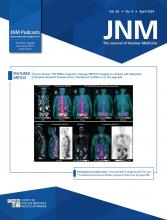Abstract
Large-molecule tracers, such as labeled antibodies, have shown success in immuno-PET for imaging of specific cell surface biomarkers. However, previous work has shown that localization of such tracers shows high levels of heterogeneity in target tissues, due to both the slow diffusion and the high affinity of these compounds. In this work, we investigate the effects of subvoxel spatial heterogeneity on measured time–activity curves in PET imaging and the effects of ignoring diffusion limitation on parameter estimates from kinetic modeling. Methods: Partial differential equations (PDE) were built to model a radially symmetric reaction-diffusion equation describing the activity of immuno-PET tracers. The effects of slower diffusion on measured time–activity curves and parameter estimates were measured in silico, and a modified Levenberg–Marquardt algorithm with Bayesian priors was developed to accurately estimate parameters from diffusion-limited data. This algorithm was applied to immuno-PET data of mice implanted with prostate stem cell antigen–overexpressing tumors and injected with 124I-labeled A11 anti–prostate stem cell antigen minibody. Results: Slow diffusion of tracers in linear binding models resulted in heterogeneous localization in silico but no measurable differences in time–activity curves. For more realistic saturable binding models, measured time–activity curves were strongly dependent on diffusion rates of the tracers. Fitting diffusion-limited data with regular compartmental models led to parameter estimate bias in an excess of 1,000% of true values, while the new model and fitting protocol could accurately measure kinetics in silico. In vivo imaging data were also fit well by the new PDE model, with estimates of the dissociation constant (Kd) and receptor density close to in vitro measurements and with order of magnitude differences from a regular compartmental model ignoring tracer diffusion limitation. Conclusion: Heterogeneous localization of large, high-affinity compounds can lead to large differences in measured time–activity curves in immuno-PET imaging, and ignoring diffusion limitations can lead to large errors in kinetic parameter estimates. Modeling of these systems with PDE models with Bayesian priors is necessary for quantitative in vivo measurements of kinetics of slow-diffusion tracers.
Footnotes
Published online ▪▪▪▪▪▪▪▪▪▪▪▪.
- © 2014 by the Society of Nuclear Medicine and Molecular Imaging, Inc.







